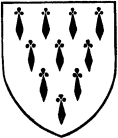
 |
| FIG. 33.--Arms of John (de Montfort, otherwise de Bretagne), Duke of Brittany and Earl of Richmond. (From his seal.) |

 where no less than forty different examples are quoted. The above-mentioned writer continues: "There is another use of a plain red shield which must not be omitted. In the full quartered coat of some high sovereign princes of Germany--Saxony (duchies), Brandenburg(Prussia), Bavaria, Anhalt--appears a plain red quartering; this is known as the Blut Fahne or Regalien quarter, and is indicative of Royal prerogatives. It usually occupies the base of the shield, and is often diapered."
where no less than forty different examples are quoted. The above-mentioned writer continues: "There is another use of a plain red shield which must not be omitted. In the full quartered coat of some high sovereign princes of Germany--Saxony (duchies), Brandenburg(Prussia), Bavaria, Anhalt--appears a plain red quartering; this is known as the Blut Fahne or Regalien quarter, and is indicative of Royal prerogatives. It usually occupies the base of the shield, and is often diapered."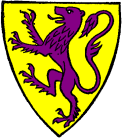 |
| FIG. 34.--Armorial bearings of Henry de Lacy, Earl of Lincoln (d. 1311): Or, a lion rampant purpure. (From his seal.) |

 speaks of his
speaks of his"Baniere ot de un cendall saffrin, O un lion rampant porprin,"
*1 The arms of Clayhills of Invergowrie: Parted per bend sanguine and vert, two greyhounds courant bendwise argent. Mantling gules doubled argent; and upon a wreath of the liveries is set for crest, an arm holding an Imperial crown proper; and in an escroll over the same, this motto, "Corde et animo." Matriculated in Lyon Office circa 1672.To these colours German heraldry has added brown, blood-red(this apparently is different from the English sanguine, as a different hatching has been invented for it), earth-colour, iron-grey, water-colour, flesh-colour, ashen-grey, orange (here also a separate hatching from the one to represent tenné has been invented), and the colour of nature, i.e. "proper." These doubtless are not intended to be added to the list of heraldic tinctures, but are noted because various hatchings have been invented in modern times to represent them.

 alludes to various tinctures amongst Continental arms which he has come across.
alludes to various tinctures amongst Continental arms which he has come across.
 remarks: "The system of hatching used by Marcus Vulson de la Colombière, 1639, in the course of time found acceptance everywhere, and has maintained itself in use unaltered until the present day, and these are shown in Fig. 35, only that later, hatchings have been invented for brown, grey, &c.; which, however, seems rather a superfluous enriching." None of these later creations, by the way, have ever been used in this country. For the sake of completeness, however, let them be mentioned(see Fig. 36): a, brown; b, blood-red; c, earth-colour; d, iron-grey; e, water-colour; f, flesh-colour; g, ashen-grey; h, orange; and i, colour of nature. In English armory "tenné" is represented by a combination of horizontal (as azure) lines with diagonal lines from sinister to dexter (as purpure), and sanguine or murrey by a combination of diagonal lines from dexter to sinister (as vert), and from sinister to dexter (as purpure).
remarks: "The system of hatching used by Marcus Vulson de la Colombière, 1639, in the course of time found acceptance everywhere, and has maintained itself in use unaltered until the present day, and these are shown in Fig. 35, only that later, hatchings have been invented for brown, grey, &c.; which, however, seems rather a superfluous enriching." None of these later creations, by the way, have ever been used in this country. For the sake of completeness, however, let them be mentioned(see Fig. 36): a, brown; b, blood-red; c, earth-colour; d, iron-grey; e, water-colour; f, flesh-colour; g, ashen-grey; h, orange; and i, colour of nature. In English armory "tenné" is represented by a combination of horizontal (as azure) lines with diagonal lines from sinister to dexter (as purpure), and sanguine or murrey by a combination of diagonal lines from dexter to sinister (as vert), and from sinister to dexter (as purpure). |
| FIG. 35. |
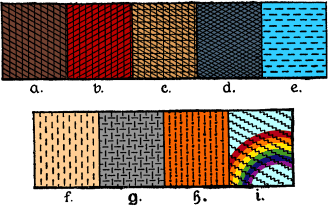 |
| FIG. 36. |

 sanctions its use; and he being the high priest of English armory to so many, his example has given the system a certain currency.
I am not myself aware of any instance of the use of these terms in an English patent of arms.
sanctions its use; and he being the high priest of English armory to so many, his example has given the system a certain currency.
I am not myself aware of any instance of the use of these terms in an English patent of arms.
 namely, "erminites," which is supposed to be white, with black ermine spots and a red hair on each side of the spot. I believe there is no instance known of any such fur in British armory. It is not mentioned in Ströhl's "Heraldic Atlas,"
namely, "erminites," which is supposed to be white, with black ermine spots and a red hair on each side of the spot. I believe there is no instance known of any such fur in British armory. It is not mentioned in Ströhl's "Heraldic Atlas,"
 nor can I find any foreign instance, so that who invented it, or for what purpose it was invented, I cannot say; and I think it should be relegated, with abatements and the seize quartiers of Jesus Christ, to the category of the silly inventions of former heraldic writers, not of former heralds, for I know of no official act which has recognised the existence of erminites. The German term for erminois is gold-hermelin, but there are no distinctive terms either in French or German heraldry for the other varieties. Thus, erminois would be in French blazon: d'or, semé d'hermines de sable; pean would be de sable, semé d'hermines d'or. Though ermine is always nowadays represented upon a white background, it was sometimes depicted with black ermine spots upon a field of silver, as in the case of some of the stall plates of the Knights of the Garter in St. George's Chapel at Windsor. Ermine spots are frequently to be found as charges. For instance, in the well-known coat of Kay, which is: "Argent, three ermine spots in bend between two bendlets sable, the whole between as many crescents azure." As charges two ermine spots figure
upon the arms recently granted to Sir Francis Laking, Bart., G.C.V.O. The ermine spot has also sometimes been used in British armory as the difference mark granted under a Royal Licence to assume name and arms when it is necessary to indicate the absence of blood relationship. Other instances of the use of an ermine spot as a charge are:--
nor can I find any foreign instance, so that who invented it, or for what purpose it was invented, I cannot say; and I think it should be relegated, with abatements and the seize quartiers of Jesus Christ, to the category of the silly inventions of former heraldic writers, not of former heralds, for I know of no official act which has recognised the existence of erminites. The German term for erminois is gold-hermelin, but there are no distinctive terms either in French or German heraldry for the other varieties. Thus, erminois would be in French blazon: d'or, semé d'hermines de sable; pean would be de sable, semé d'hermines d'or. Though ermine is always nowadays represented upon a white background, it was sometimes depicted with black ermine spots upon a field of silver, as in the case of some of the stall plates of the Knights of the Garter in St. George's Chapel at Windsor. Ermine spots are frequently to be found as charges. For instance, in the well-known coat of Kay, which is: "Argent, three ermine spots in bend between two bendlets sable, the whole between as many crescents azure." As charges two ermine spots figure
upon the arms recently granted to Sir Francis Laking, Bart., G.C.V.O. The ermine spot has also sometimes been used in British armory as the difference mark granted under a Royal Licence to assume name and arms when it is necessary to indicate the absence of blood relationship. Other instances of the use of an ermine spot as a charge are:--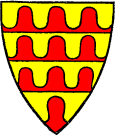 |
| FIG. 37.--Arms of William de Ferrers, Earl of Derby (d. 1247): "Scutum variatum auro & gul." (From MS. Cott. Nero, D. I.) |
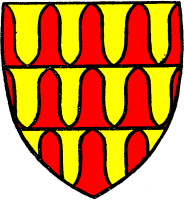 |
| FIG. 38.--Anns of Robert de Ferrers, Earl of Derby (1254-1265). (From stained glass in Dorchester Church.) |

 may be noted in passing. The familiar fairy tale of Cinderella was brought to us from the French, and the slippers made of this costly fur, written, probably, verre for vairé, were erroneously translated "glass" slippers. This was, of course, an impossible material, but the error has always been repeated in the nursery tale-books.
may be noted in passing. The familiar fairy tale of Cinderella was brought to us from the French, and the slippers made of this costly fur, written, probably, verre for vairé, were erroneously translated "glass" slippers. This was, of course, an impossible material, but the error has always been repeated in the nursery tale-books.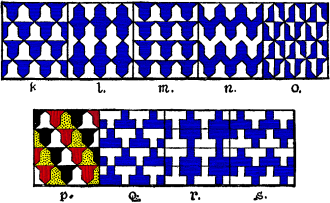 |
| FIG. 39. |
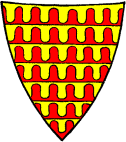 |
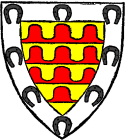 |
| FIG. 40.--Arms of Robert de Ferrers, Earl of Derby (1254-1265). (From his seal.) | FIG. 41.--Arms of William de Ferrers, Earl of Derby: Vairé, or, and gules, a bordure argent, charged with eight horseshoes sable. (From a drawing of his seal, MS. Cott. Julius, C vii.) |

 refers to the coat of Roger Holthouse, which he blazons: "Vairy argent, azure, gules, and or, en point."
refers to the coat of Roger Holthouse, which he blazons: "Vairy argent, azure, gules, and or, en point."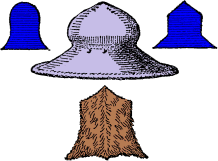 |
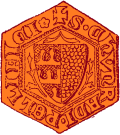 |
| FIG. 42. | FIG. 43.--Seal of Chimrad Pellifex, 1329. |

 writes: "Two curious forms of Vair occasionally met with in Italian or French coats are known as Plumeté and Papelonné.
writes: "Two curious forms of Vair occasionally met with in Italian or French coats are known as Plumeté and Papelonné. "So olde she was, that she ne went
A fote, but it were by potent."

 he enumerates some twenty-six instances of the violation of the rule. The whole of the instances he quoted, however, are taken from Continental armory, in which these exceptions--for even on the Continent such armes fausses are noticeable exceptions--occur much more frequently than in this country. Nevertheless such exceptions do occur in British armory, and the following instances of well-known coats which break the rule may be quoted.
he enumerates some twenty-six instances of the violation of the rule. The whole of the instances he quoted, however, are taken from Continental armory, in which these exceptions--for even on the Continent such armes fausses are noticeable exceptions--occur much more frequently than in this country. Nevertheless such exceptions do occur in British armory, and the following instances of well-known coats which break the rule may be quoted.
 says this coat of arms was granted to Cadifor ap Dyfnwal, ninth in descent from Roderick the Great, Prince of Wales, by his cousin the great Lord Rhys, for taking the castle of Cardigan by escalade from the Earl of Clare and the Flemings in 1164. Another instance is a coat of Meredith recorded in Ulster's Office and now inherited by the Hon. Richard Edmund Meredith, a judge of the Supreme Court of Judicature of Ireland and a Judicial Commissioner of the Irish Land Commission. These arms are: "Gules, on a chevron sable, between three goats' heads erased, as many trefoils or." An instance of comparatively recent date will be found in the grant of the arms of Thackeray. A little careful research, no doubt, would produce a large number of English instances, but one is bound to admit the possibility that the great bulk of these cases may really be instances of augmentation.
says this coat of arms was granted to Cadifor ap Dyfnwal, ninth in descent from Roderick the Great, Prince of Wales, by his cousin the great Lord Rhys, for taking the castle of Cardigan by escalade from the Earl of Clare and the Flemings in 1164. Another instance is a coat of Meredith recorded in Ulster's Office and now inherited by the Hon. Richard Edmund Meredith, a judge of the Supreme Court of Judicature of Ireland and a Judicial Commissioner of the Irish Land Commission. These arms are: "Gules, on a chevron sable, between three goats' heads erased, as many trefoils or." An instance of comparatively recent date will be found in the grant of the arms of Thackeray. A little careful research, no doubt, would produce a large number of English instances, but one is bound to admit the possibility that the great bulk of these cases may really be instances of augmentation.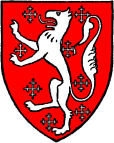 |
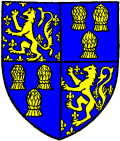 |
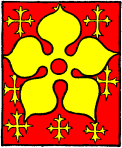 |
| FIG. 44.--Arms of John, Lord De la Warr (d. 1398). (From MS. Ashm. 804, iv.) | FIG. 45.--Arms of John, Lord Beaumont, K. G.. (d, 1396). From his Garter Plate: 1 and 4, Beaumont; 2 and 3, azure, three garbs or (for Comyn). | FIG. 46.--Arms of Gilbert Umfraville, Earl of Kyme (d. 1421). (From Harl. MS. 6163.) |
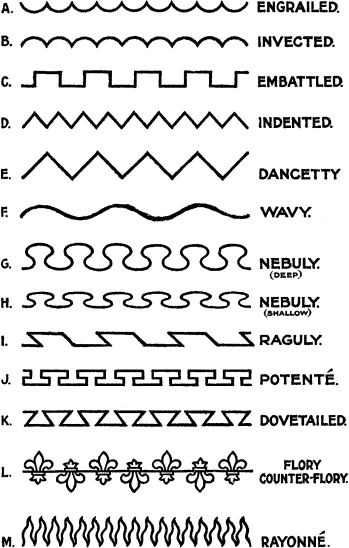 |
| FIG. 47.--Lines of Partition. |

 even in the edition of 1724, does not mention any of the remaining terms. Dovetailed in modern armory is even yet but seldom made use of, though I can quote two instances of coats of arms in which it is to be found, namely, the arms of Kirk, which are: "Gules, a chevron dovetailed ermine, on a chief argent,
three dragons' heads couped of the field;" and Ambrose: "Azure, two lions passant in pale argent, on a chief dovetailed of the last, a fleur-de-lis between two annulets of the first." Other instances of dovetailed used as a line of partition will be found in the case of the arms of Farmer, which are: "Per chevron dovetailed gules and argent, in chief two lions' heads erased of the
last, and in base a salamander in flames proper;" and in the arms of Fenton namely: "Per pale argent and sable, a cross dovetailed, in the first and fourth quarters a fleur-de-lis, and in the second and third a trefoil slipped all countercharged." There are, of course, many others. The term potenté, as will be seen from a reference to Fig. 47, is used to indicate a line which follows the form of the division lines in the fur potent. As one of the partition lines potenté is very rare.
even in the edition of 1724, does not mention any of the remaining terms. Dovetailed in modern armory is even yet but seldom made use of, though I can quote two instances of coats of arms in which it is to be found, namely, the arms of Kirk, which are: "Gules, a chevron dovetailed ermine, on a chief argent,
three dragons' heads couped of the field;" and Ambrose: "Azure, two lions passant in pale argent, on a chief dovetailed of the last, a fleur-de-lis between two annulets of the first." Other instances of dovetailed used as a line of partition will be found in the case of the arms of Farmer, which are: "Per chevron dovetailed gules and argent, in chief two lions' heads erased of the
last, and in base a salamander in flames proper;" and in the arms of Fenton namely: "Per pale argent and sable, a cross dovetailed, in the first and fourth quarters a fleur-de-lis, and in the second and third a trefoil slipped all countercharged." There are, of course, many others. The term potenté, as will be seen from a reference to Fig. 47, is used to indicate a line which follows the form of the division lines in the fur potent. As one of the partition lines potenté is very rare.
 gives a curious assortment of lines, the most curious of all, perhaps, being indented embowed, or hacked and hewed. Where such a term originated or in what coat of arms it is to be found I am ignorant, but the appearance is exactly what would be presented by a piece of wood hacked with an axe at regular intervals. Elvin again makes a difference between bretessed and embattled-counter-embattled, making the embattlement on either side of an ordinary identical in the former and alternated in the latter. He
also makes a difference between raguly, which is the conventional form universally adopted, and raguled and trunked, where the ordinary takes the representation of the trunk of a tree with the branches lopped; but these and many others that he gives are refinements of idea which personally I should never expect to find in actual use, and of the instances of which I am unaware. I think, however, the term "rayonné," which is found in both the arms of O'Hara and the arms of Colman, and which is formed by the addition of rays to the ordinary, should take a place amongst lines of partition, though I admit I know of no instance in which it is employed to divide the field.
gives a curious assortment of lines, the most curious of all, perhaps, being indented embowed, or hacked and hewed. Where such a term originated or in what coat of arms it is to be found I am ignorant, but the appearance is exactly what would be presented by a piece of wood hacked with an axe at regular intervals. Elvin again makes a difference between bretessed and embattled-counter-embattled, making the embattlement on either side of an ordinary identical in the former and alternated in the latter. He
also makes a difference between raguly, which is the conventional form universally adopted, and raguled and trunked, where the ordinary takes the representation of the trunk of a tree with the branches lopped; but these and many others that he gives are refinements of idea which personally I should never expect to find in actual use, and of the instances of which I am unaware. I think, however, the term "rayonné," which is found in both the arms of O'Hara and the arms of Colman, and which is formed by the addition of rays to the ordinary, should take a place amongst lines of partition, though I admit I know of no instance in which it is employed to divide the field. Per fess . . . . . Fig. 48
Per bend . . . . . Fig. 49
Per bend sinister . . Fig. 50
Per pale . . . . . Fig. 51
Per chevron . . . . Fig. 52
Per cross . . . . . Fig. 53
(though it should be noted that the more usual term em-
ployed for this is "quarterly")
Per saltire . . . . Fig. 54
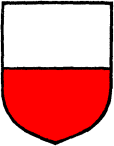 |
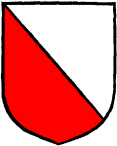 |
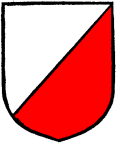 |
| FIG. 48.--Per fess. | FIG. 49.--Per bend. | FIG. 50.--Per bend sinister |
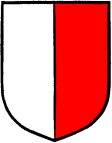 |
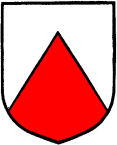 |
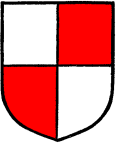 |
| FIG. 51.--Per pale. | FIG. 52.--Per chevron. | FIG. 53.--Per cross or quarterly. |
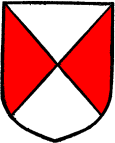 |
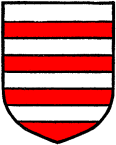 |
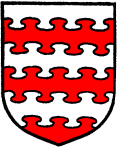 |
| FIG. 54.--Per saltire. | FIG. 55.--Barry. | FIG. 56.--Barry nebuly. |
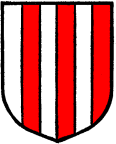 |
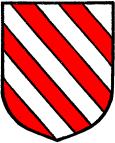 |
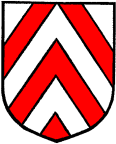 |
| FIG. 57.--Paly. | FIG. 58.--Bendy. | FIG. 59.--Chevronny. |